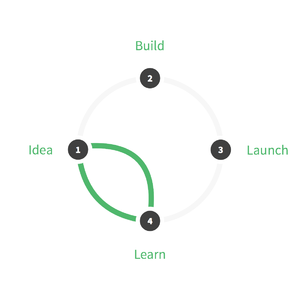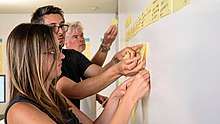Design sprint
A design sprint is a time-constrained, five-phase process that uses design thinking with the aim of reducing the risk when bringing a new product, service or a feature to the market. The process aims to help teams to clearly define goals, validating assumptions and deciding on a product roadmap before starting development. It seeks to address strategic issues using interdisciplinary, rapid prototyping, and usability testing. This design process is similar to Sprints in an Agile development cycle.[1]

Possible uses
Claimed uses of the approach include
- Launching a new product or a service.
- Extending an existing experience to a new platform.
- Existing MVP needing revised User experience design and/or UI Design.
- Adding new features and functionality to a digital product.
- Opportunities for improvement of a product (e.g. a high rate of cart abandonment[2])
- Opportunities for improvement of a service.[3]
- Supporting organisations in their transformation towards new technologies (e.g., AI). [4]
Phases

The creators of the design sprint approach, recommend preparation by picking the proper team, environment, materials and tools working with six key 'ingredients'.[5]
- Understand: Discover the business opportunity, the audience, the competition, the value proposition, and define metrics of success.
- Diverge: Explore, develop and iterate creative ways of solving the problem, regardless of feasibility.
- Converge: Identify ideas that fit the next product cycle and explore them in further detail through storyboarding.
- Prototype: Design and prepare prototype(s) that can be tested with people.
- Test: Conduct 1:1 usability testing with 5-6 people from the product's primary target audience. Ask good questions.[6]
Deliverables
The main deliverables after the Design sprint:
- Answers to a set of vital questions
- Findings from the sprint (notes, user journey maps, storyboards, information architecture diagrams, etc.)
- Prototypes
- Report from the usability testing with the findings (backed by testing videos)
- A plan for next steps
- Validate or invalidate hypotheses before committing resources to build the solution
Team
The suggested ideal number of people involved in the sprint is 4-7 people and they include the facilitator, designer, a decision maker (often a CEO if the company is a startup), product manager, engineer and someone from companies core business departments (Marketing, Content, Operations, etc.).
References
- "Off To The Races: Getting Started With Design Sprints – Smashing Magazine". Smashing Magazine. Retrieved 2016-03-08.
- "Why Online Retailers Are Losing 67.45% of Sales and What to Do About It – Shopify". Shopify's Ecommerce Blog - Ecommerce News, Online Store Tips & More. Retrieved 2016-03-08.
- "Service design sprints deliver speedy solutions". reminetwork. Retrieved 2016-03-08.
- "About AI Design Sprints". 33A. Retrieved 2020-03-06.
- "From Google Ventures, The 6 Ingredients You Need To Run A Design Sprint". Co.Design. Retrieved 2016-03-08.
- Matveeva, Maria (March 10, 2015). "Ask good questions". Dockyard.